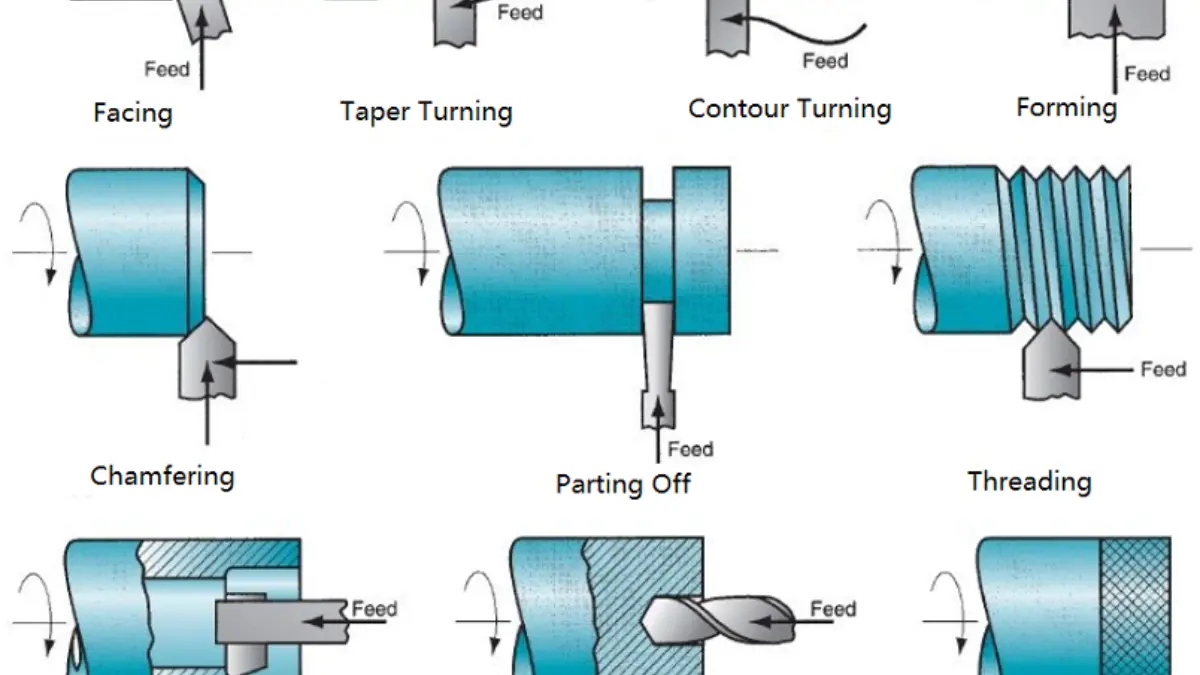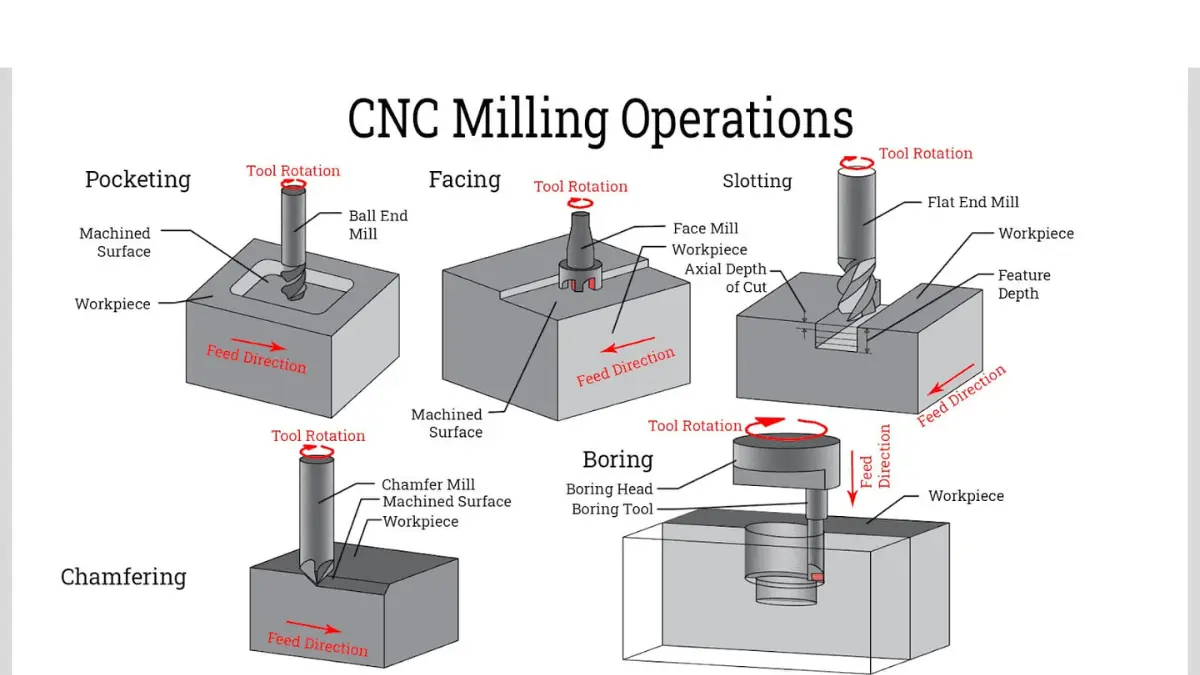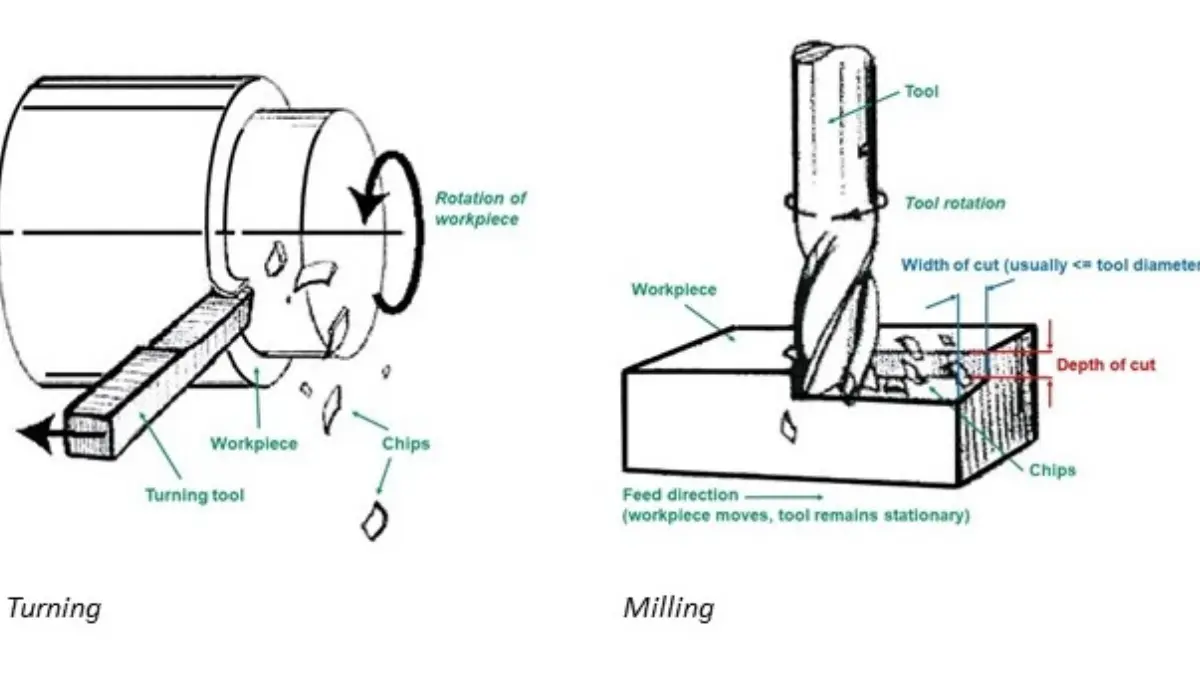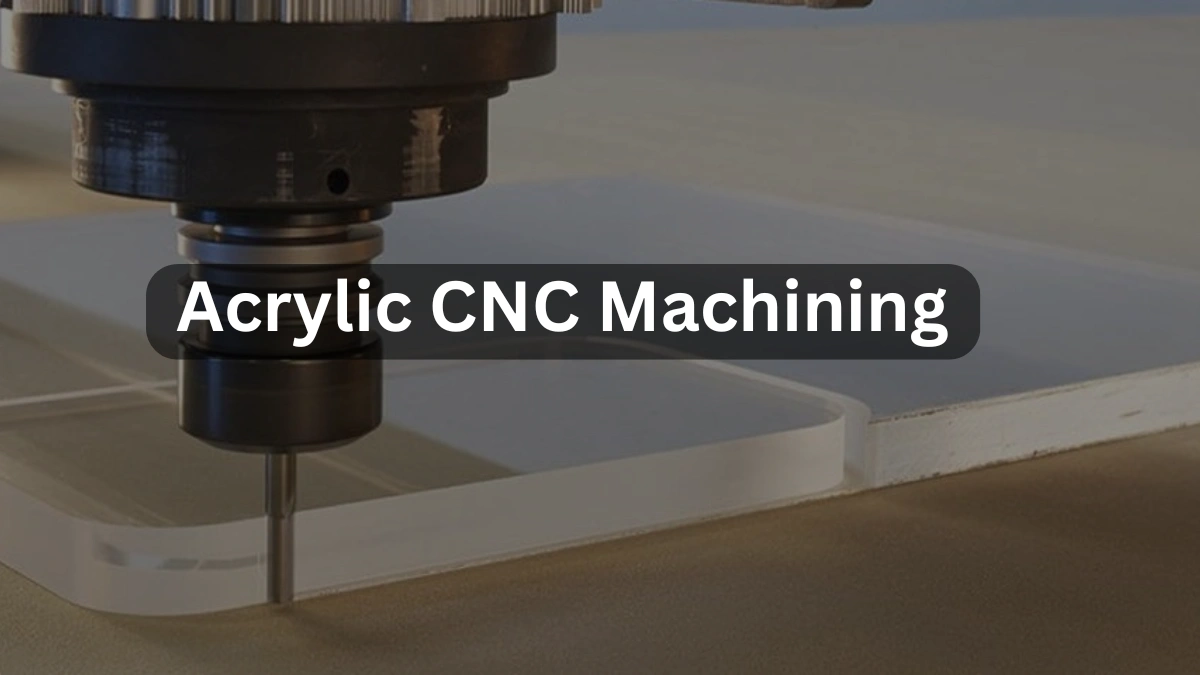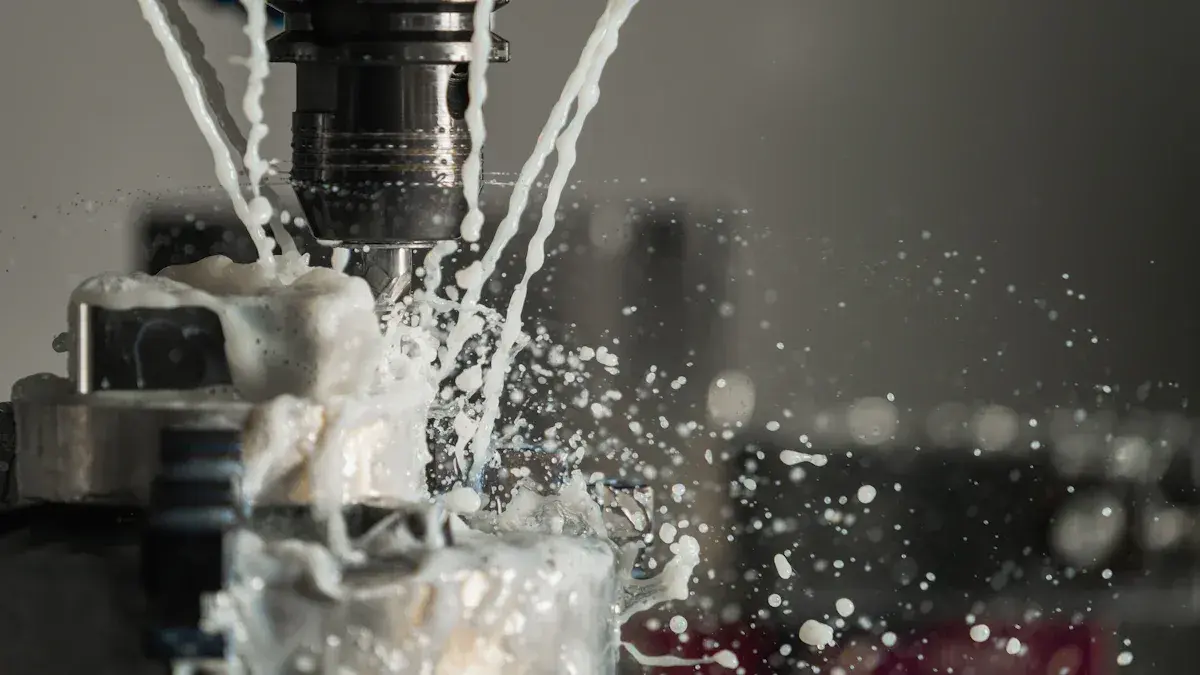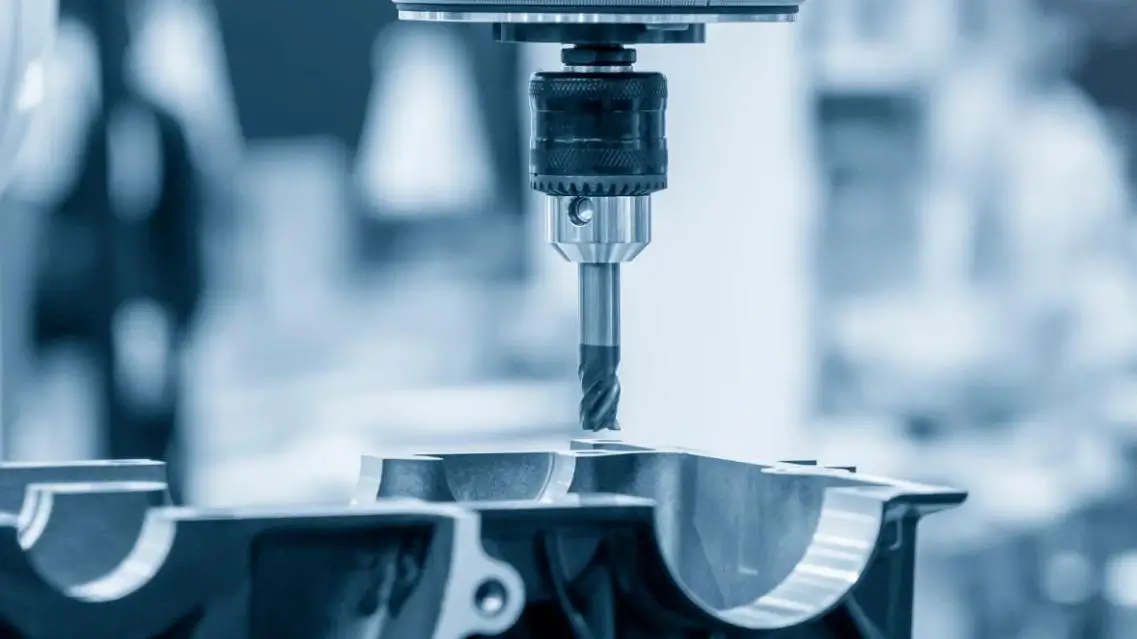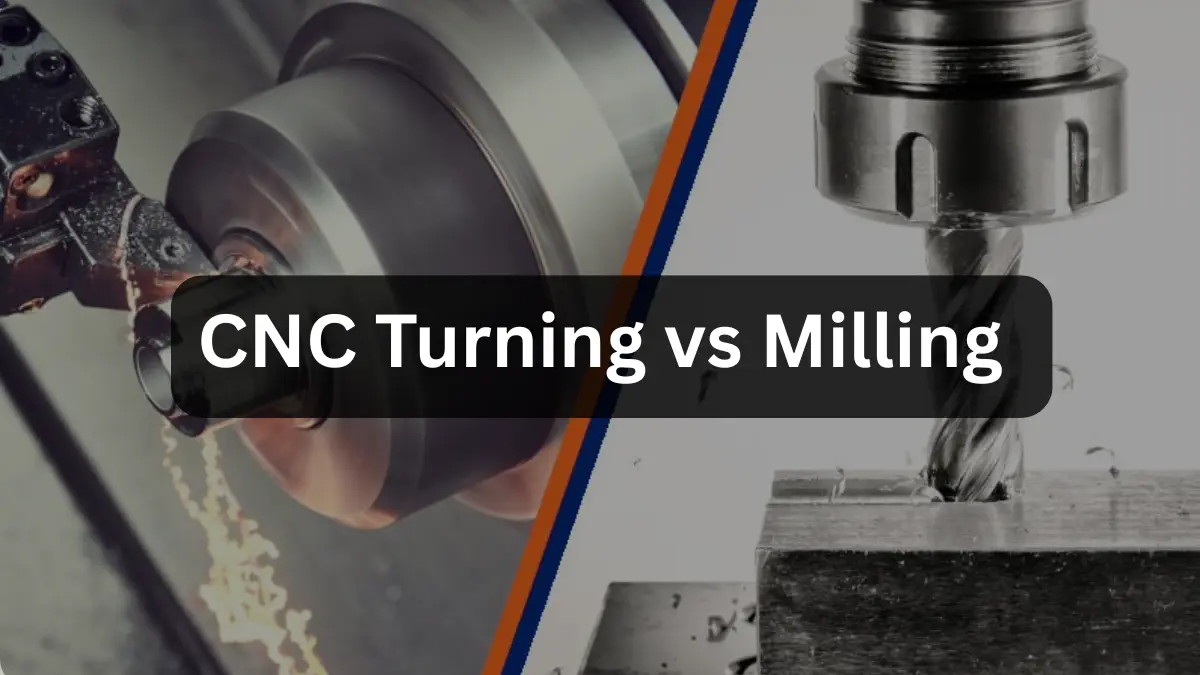
The main difference between CNC turning vs milling is that Turning’s core is workpiece rotation. Milling’s core is tool rotation. CNC turning shapes cylindrical parts. The workpiece spins and a fixed tool removes material. This process is fast for round shapes. CNC milling creates complex shapes. The cutting tool rotates. The workpiece stays still. Milling performs better at complex details. Each has unique strengths for different needs.
Key Takeaways of The Article
- What is CNC Turning?
- What is CNC Milling?
- Main Differences Between CNC Turning and Milling
- Choose Between CNC Turning and Milling
Understanding CNC Turning
What is CNC Turning?
CNC turning creates cylindrical parts by rotating material against cutting tools. So the basic point is that while the workpiece spins, tools remove material to create your desired shape. You will see this process in action whenever perfectly round parts are needed.
The main components in CNC turning include:
- The chuck (which holds and rotates the workpiece)
- The cutting tools
- Toolholder
- And the computer control system.
Common applications? You can say it is the most common fault to think turning only makes simple parts. In reality, CNC turning creates complex components like:
- Shafts and axles for vehicles
- Precision medical implants
- Custom fasteners and fittings
- Gun barrels and components
- Aerospace fuel system parts
How CNC Turning Works
The CNC turning process starts with a material blank secured in a chuck that rotates at high speed. Next thing is, cutting tools mounted on a turret move against this spinning material, slicing away excess material layer by layer. This point is noticeable – unlike milling where the tool rotates, in turning, the workpiece rotates while tools remain relatively stationary.
CNC turning involves several operations beyond the basics. Facing creates flat surfaces at the ends. Form turning creates complex contours in a single pass. Taper turning produces conical shapes. Knurling creates textured grip patterns. Thread whirling generates precision threads for medical screws and implants. Be yourself when selecting operations – experienced programmers combine these techniques to minimize cycle times.
The workholding systems deserve special attention. Three-jaw chucks provide quick centering for most work. Collet chucks offer better concentricity for precision parts. Four-jaw independent chucks handle irregular shapes. Engineers know it – using steady rests and live centers supports longer workpieces that might otherwise deflect under cutting forces.
Cutting parameters directly impact quality and efficiency. So you see, spindle speed (RPM) depends on material and diameter (Speed = Cutting Speed ÷ Diameter × 12). Feed rates typically range from 0.005-0.020 inches per revolution for finishing cuts. Depth of cut varies with material hardness and machine rigidity. Customers pay attention to tooling cost also since proper tool selection dramatically affects part quality and production costs.
Advantages of CNC Turning
Speed stands out as a major advantage of CNC turning. Be spontaneous in your production planning – turning operations can complete parts much faster than milling for cylindrical shapes. A skilled programmer can optimize cycle times to maximize efficiency.
Precision reaches impressive levels in modern CNC turning. So you see quality machines easily maintain tolerances of 0.01mm inches. However, our maximum capability is 0.005mm. This precision makes turning perfect for components where proper fit matters most.
For high-volume production, turning offers incredible cost advantages. This point is important for manufacturers needing thousands of identical parts. The faster cycle times, lower labor requirements, and reduced material waste translate to significant savings compared to other methods.
Limitations of CNC Turning
Despite its advantages, CNC turning has design limitations. You know, turning works primarily for cylindrical shapes and those with radial symmetry. Creating non-cylindrical features requires additional operations or different processes entirely.
Material constraints also exist. Extremely hard materials can wear tools quickly. Very soft or flexible materials might deflect during turning. Do not panic though – experienced machinists develop techniques to work around these challenges, like using special workholding devices or modified cutting strategies.
Exploring CNC Milling
What is CNC Milling?
In CNC milling, create parts by using rotating cutting tools. The purpose is to remove material from a stationary workpiece. So this is basically different from turning. For example, in milling, the tool rotates while the workpiece remains fixed.
So, you see, milling has an edge at creating parts with complex geometries, flat surfaces, and complex features. Common applications include:
- Engine blocks and cylinder heads
- Molds and dies for manufacturing
- Custom fixtures and jigs
- Electronic enclosures and heat sinks
- Architectural components and prototypes
How CNC Milling Works
In simple words, CNC milling works by spinning cutting tools at high speed while moving either the tool or the workpiece along multiple axes. Modern milling centers operate with increasing complexity: 3-axis machines handle most basic work, 4-axis adds rotation around one axis, and 5-axis systems can approach workpieces from virtually any angle.
Milling strategies dramatically impact results. Climb milling (cutter rotation matches feed direction) produces better finishes but requires rigid setups. Conventional milling (cutter rotation opposes feed) works better on older machines. Adaptive clearing and trochoidal toolpaths reduce tool loads by maintaining consistent engagement. This point is important for extending tool life when machining tough materials.
The tools used in milling deserve special attention. Square end mills create sharp corners and slots. Ball nose mills generate contoured surfaces. Bull nose (corner radius) mills balance strength and detail. Flute count matters too – fewer flutes (2-3) for aluminum and non-ferrous materials, more flutes (4+) for steels. You know, proper tool selection affects not just accuracy but also cycle time and tool life. Find balance between speed and tool longevity when setting cutting parameters.
Advantages of CNC Milling
Versatility stands as milling’s greatest strength. You will see milling machines creating everything from simple blocks to highly complex 3D contours. This flexibility makes milling indispensable in product development and manufacturing environments.
Multi-axis machining capabilities take this versatility further. 5-axis milling centers can approach workpieces from virtually any angle, creating geometries impossible with simpler machines. Be yourself when designing – modern milling removes many traditional manufacturing constraints.
Material compatibility impresses even veteran machinists. CNC milling works with everything from soft plastics to hardened tool steels. This point is important for manufacturers needing flexibility in their material selection.
Limitations of CNC Milling
Speed limitations exist when comparing milling to turning for certain applications. Definitely it is obvious that creating a simple cylindrical part takes longer on a mill than a lathe. Production planners must consider this when scheduling work.
Cost factors into decisions about milling equipment. Advanced CNC milling centers with multiple axes and automatic tool changers represent significant investments. Start somewhere – smaller shops often begin with 3-axis machines and expand capabilities as business grows.
Key Differences Between CNC Turning and Milling
Process Comparison
The fundamental difference between turning and milling lies in how material moves during cutting. In turning, the workpiece rotates while tools remain relatively fixed. In milling, cutting tools rotate while the workpiece moves through the workspace.
Material removal also differs significantly. You know, turning removes material in a continuous strip or ribbon, while milling creates small chips with each tooth engagement. This affects cutting forces, tool selection, and finishing requirements.
Surface finish characteristics vary dramatically between processes. CNC turning typically produces surface finishes between 32–63 µin without special operations. Tool nose radius directly impacts this – larger radii create smoother finishes but may cause vibration on slender parts. This point is noticeable when comparing turned surfaces (concentric tool marks) versus milled surfaces (visible cusps from tool paths).
Speed and Efficiency Comparison
Turning generally offers faster material removal rates for cylindrical parts. Notice things like how a simple round shaft might take minutes on a lathe but hours on a mill. This efficiency makes turning the go-to process for high-volume production of cylindrical components.
Energy consumption patterns differ too. CNC turning machines typically use less power than comparable milling centers because they have fewer moving components and simpler motion systems. Find balance between process capabilities and operational costs when selecting equipment.
Precision and Tolerances
Both processes achieve impressive precision, but in different ways. In CNC turning, machining companies can generally obtain tolerances of ±0.0005″ (0.013mm) on diameter dimensions. Subsequently, it can reach ±0.0002″ (0.005mm) with proper tooling and careful setup. Customers are so right in their opinion that turning produces better roundness than milling in most cases. For example, they get roundness within 0.0001″ (0.0025mm) is achievable on precision lathes.
CNC milling is also flawless with positional tolerances – placing features in precise relationships to each other within ±0.001″ (0.025mm) on standard machines and down to ±0.0005″ (0.013mm) on high-end equipment. This point is noticeable in aerospace applications where hole patterns must maintain exact relationships across large components. Flatness of 0.001″ per 12″ is typical.
Geometric tolerances like cylindricity and concentricity favor turning operations, while parallelism and perpendicularity often favor milling. Look within your specific requirements to determine which process better suits your precision needs.
Cost Comparison
Machine costs vary significantly. Entry-level CNC lathes generally cost less than comparable milling centers. However, advanced multi-axis turning centers with live tooling can match or exceed the price of sophisticated mills.
Operational costs deserve careful consideration. Have patience when analyzing total costs – tool life, programming complexity, setup time, and cycle time all affect the bottom line. Everything counts when calculating the true cost per part.
For different production volumes, the cost advantage shifts. Turning usually wins for high-volume cylindrical parts. Milling often proves more economical for complex, low-volume components where setup amortization matters less.
Choosing Between CNC Turning and Milling: Which One to Use?
Factors Influencing Your Decision
The part’s structure (shape) is the most critical factor when deciding between turning and milling. Hard materials with high tensile strength often machine better in turning operations where cutting forces distribute differently than in milling.
Project complexity guides process selection. Simple cylindrical parts naturally suit turning. Components with multiple flat surfaces and complex features typically require milling. Infinite possibilities exist between these extremes where either process might work with appropriate tooling and fixturing.
Production volume affects the economics dramatically. High-volume production generally favors turning for round parts due to faster cycle times and lower labor costs. Low-volume or prototype work often benefits from milling’s flexibility.
Required tolerances also matter greatly. Stay focused on your most critical dimensions when selecting a process. Some geometrical tolerances are easier to achieve with specific processes.
When to Use CNC Turning
CNC turning proves ideal for shaft-like components, cylindrical parts, and anything with rotational symmetry. Pretty awesome results come from turning when making:
- Precision shafts and axles
- Bearing races and housings
- Threaded components
- Pulleys and similar rotating parts
- Parts requiring excellent concentricity
Material removal rates tell a compelling story. For example, turning mild steel typically removes 1-3 cubic inches per minute compared to 0.5-1.5 cubic inches for comparable milling operations on cylindrical parts. This means turning can be twice as fast for the right geometries. Why does it matter? In high-volume production, this efficiency translates directly to lower per-part costs.
A practical example comes from automotive manufacturing, where fuel injector components require micron-level precision in roundness and diameter. CNC turning delivers 0.0001″ (0.0025mm) roundness consistently at production rates of hundreds per hour, making it the only viable option for such components. So the basic point is that when parts have primarily rotational features, turning should be your first consideration.
When to Use CNC Milling
CNC milling remains ahead when creating parts with flat surfaces, pockets, contours, and complex 3D geometries. Just because a part has some cylindrical features doesn’t automatically make it a turning candidate. Milling works best for:
- Engine blocks and heads
- Custom electronic enclosures
- Molds and dies
- Parts with multiple pockets and features
- Components requiring precise hole patterns
Medical device manufacturers often choose milling for creating surgical instruments with complex ergonomic handles and precise feature relationships that would be impossible on turning equipment alone.
Can They Be Used Together?
Hybrid machining systems combine turning and milling capabilities in a single machine. These advanced centers can perform turning operations, then use powered tooling to mill features without requiring a second setup. This capability proves invaluable for complex parts requiring both processes.
The benefits of hybrid systems manifest in reduced setup time, improved accuracy between features, and lower labor costs. Aerospace manufacturers particularly value these capabilities when creating complex components where relationships between turned and milled features must remain precise.
Common CNC Turning and Milling Materials
Materials Suitable for CNC Turning
Metal turning remains extremely common, with alloy steels, aluminum, brass, and copper being frequent choices. CNC turning shops regularly work with these materials using appropriate cutting tools and coolants.
Plastics and composites also turn well under proper conditions. Materials like Delrin (acetal), nylon, and polycarbonate machine beautifully on lathes with the right cutting parameters and tools.
Certain materials present challenges in turning operations. Very hard materials like hardened steel or titanium require specialized carbide or ceramic tooling. Extremely soft materials may deflect during machining, requiring special workholding solutions.
Materials Suitable for CNC Milling
CNC milling accommodates an impressive range of materials. Titanium, stainless steel, and brass machine well with proper tooling and cutting parameters. Advanced machines give you more control over difficult materials through optimized spindle speeds and feed rates.
Harder materials like ceramics, hardened tool steels, and glass can be milled with specialized tooling like diamond-coated end mills. This point is important for industries needing precision components from extremely hard materials.
Material selection challenges often relate to workholding and cutting forces. Thin materials may warp under cutting pressure. Very hard materials dramatically reduce tool life. Experienced programmers develop strategies to overcome these limitations.
CNC Turning vs Milling: Industries and Applications
Industries That Rely on CNC Turning
The automotive industry depends heavily on turned components like shafts, pistons, and valve components. The high-volume nature of automotive manufacturing makes turning’s speed advantages particularly valuable.
Aerospace manufacturers use CNC turning for critical components like turbine shafts, fuel system components, and landing gear parts. The extreme precision and reliability of modern CNC turning makes it essential for these safety-critical applications.
Medical device manufacturing relies on turning for implantable components, surgical instruments, and diagnostic equipment parts. The ability to maintain micron-level tolerances makes turning indispensable in this highly regulated industry.
Industries That Rely on CNC Milling
The electronics industry depends on milling for creating enclosures, heat sinks, and specialized mounting hardware. The ability to create complex cooling geometries and precise mounting features makes milling essential for modern electronic systems.
Tool and die making represents another milling-intensive industry. Creating molds and dies requires the ability to machine complex 3D contours with extreme precision – capabilities that multi-axis milling centers provide.
Prototyping and custom manufacturing businesses typically center around milling capabilities. The flexibility to create almost any geometry from a wide range of materials makes milling the cornerstone of prototyping operations.
Applications Where Both CNC Turning and Milling Are Used
Automotive and aerospace components frequently require both processes. Engine components like crankshafts start as turned parts but require milled features like keyways and bolt patterns. This combined approach ensures optimal efficiency and precision.
High-precision parts in industries like medical devices and scientific instruments often require both processes. A surgical tool might have a turned handle portion and milled cutting features.
Prototyping complex designs often involves both processes. Product developers frequently use turning for cylindrical portions of prototypes, then move to milling for adding complex features. What is the benefit? This combined approach minimizes production time while maintaining design intent.
How to Select the Right CNC Machine for Your Business
Choosing the Right CNC Turning Machine
When selecting turning equipment, consider size capacity, power, and automation level. Determine your typical workpiece dimensions and required tolerances before investing. Small lathes cost less but limit your capabilities, while larger machines handle bigger parts but require more space and power.
Popular turning machines come in various configurations. Two-axis lathes handle basic turning operations economically. Multi-axis turning centers with live tooling provide more flexibility but cost significantly more. Swiss-type automatic lathes excel at small, precise components in high volumes.
Choosing the Right CNC Milling Machine
Milling machine selection depends on workpiece size, complexity, and production volume. Three-axis vertical mills provide an excellent starting point for many shops. Five-axis machines cost more but create complex geometries in single setups.
Consider tooling, workholding, and material compatibility when selecting milling equipment. Heavier machines with rigid frames generally produce better results on tough materials like titanium or hardened steel. Lighter machines may offer better economics for aluminum and plastics.
Investment Considerations
From a machining company’s perspective, the choice of machine tool and its ROI are critical. Clients, however, tend to have different priorities like they prefer the final product results. Return on investment calculations should include:
- Expected utilization rates
- Labor savings from automation
- Quality improvements
- New capability-driven business opportunities
- Training requirements for operators and programmers
Conclusion
CNC turning and milling represent complementary technologies in modern manufacturing. Turning excels at creating cylindrical parts quickly and economically. Milling offers impeccable versatile features for complex geometries and non-cylindrical features.
As manufacturing technology continues advancing, the lines between turning and milling blur further. Hybrid machines combining both capabilities become more accessible. Software improvements make programming these complex systems increasingly straightforward.

